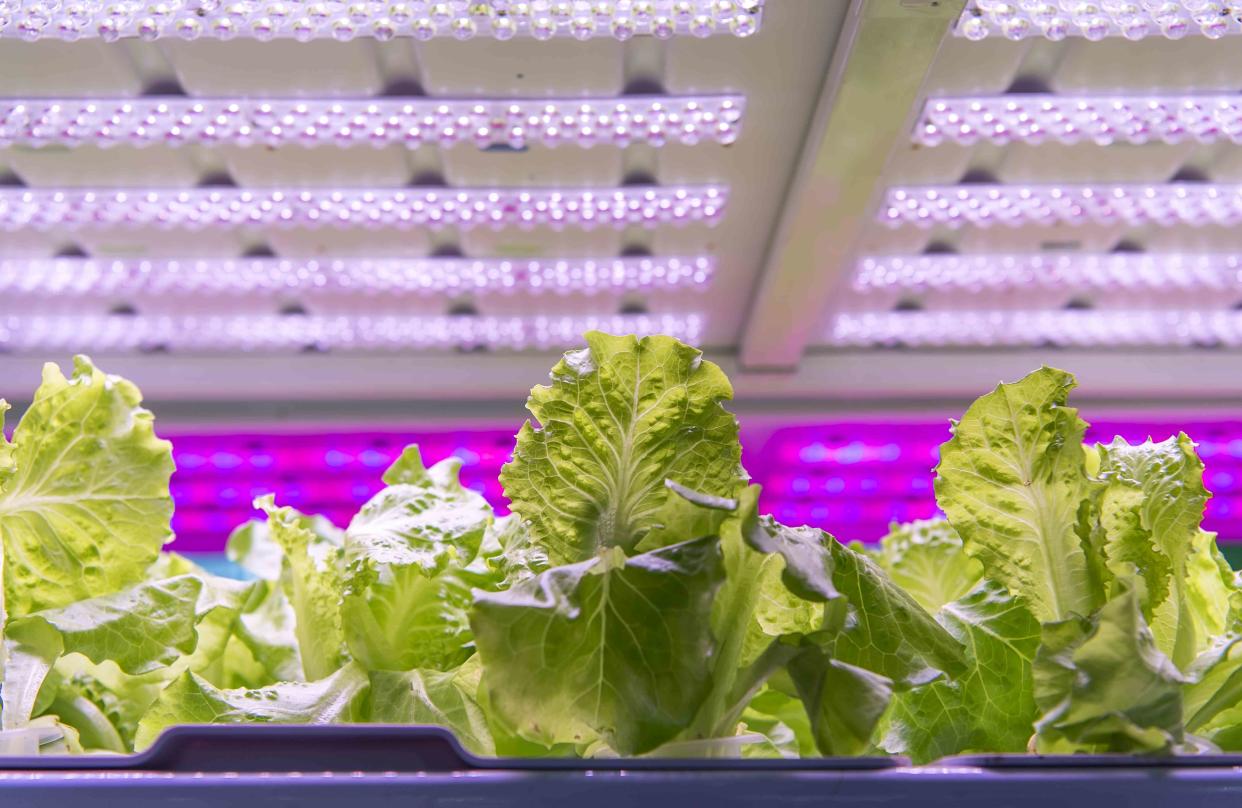What Color Light Is Best for Plant Growth?

kynny / Getty Images
Whether your home is lacking some natural light, or you are just looking to provide your plants with a little boost, a grow light is a great addition to any indoor plant setup. However, there are a few things to consider before you run out and buy the first grow light that you see. One of the most important things to consider is the color of light that the grow light emits and understanding which one works the best for your plant.
The Visible Light Spectrum
The first step to understanding grow lights is the electromagnetic spectrum. The visible light spectrum is a segment of the larger electromagnetic spectrum containing the light visible to the human eye. Two measurements to know are Kelvin and nanometers.
Kelvin (K) measures the color temperatures of the full light spectrum. This covers whether your light bulbs will be warm or cool. Today's LED grow lights typically have a Kelvin range of 2,700 to 6,500. If you're looking to promote vegetative growth in your plants or flowers, it's vital to pick a light that falls in the range of 5,000 to 7,500 Kelvin. Bulbs on the lower end of the Kelvin spectrum are better suited to promote flowering and fruiting.
Nanometers measure the specific wavelengths of specific colored lights. This includes wavelengths from about 380 to 750 nanometers.
As you might imagine, the visible light spectrum is also what drives organism growth and photosynthesis. The range of visible light plants use to drive photosynthesis ranges from about 400 to 700 nanometers and is referred to as Photosynthetically Active Radiation (PAR). PAR includes blue light (400 to 520 nanometers) and red light (630 to 700 nanometers) and everything in between. While blue and red light have been recognized as particularly significant to plant growth and the photosynthesis process, it’s essential to know that the entire PAR spectrum (including green and yellow light) is important to supporting balanced, healthy plant growth.
Red vs. Blue Light
While the entire PAR spectrum is used during photosynthesis, red and blue light make up the majority of light used by plants. Each type of light supports plant growth and development in a unique way.
Red light primarily supports the growth of stems and expansion of leaves and regulates flowering, germination, and dormancy. On the other hand, blue light is responsible for chlorophyll production, root growth, and leaf thickness.
The importance of red versus blue light is sometimes simplified to a difference in promoting flowering versus vegetative growth, but the role of each type of light shouldn’t be simplified so easily. In the end, both red and blue light are essential for plant growth and development and no plant can survive long-term without one or the other.
The Best Light for Plant Growth
So what type of light is best for encouraging plant growth? The short answer is that there isn’t one color of light that is better than the other, as they are all essential. That being said, there are times when growers will utilize grow lights that are heavier in one color of light.
For example, in large commercial applications, growers are usually pickier with the type of light that they expose their plants to as they are trying to achieve specific outcomes and large yields. So they will cycle through lights that are heavier in blue light or red light depending on where their plants are in the growing cycle. However, for most small-scale, residential applications (like houseplants), this kind of thing isn’t necessary. A grow light that provides the entire PAR spectrum is ideal.
Choosing the Right Grow Light
So all of that being said, what should you look out for when purchasing a grow light for your houseplants? First, while there are a few different kinds of grow lights available on the market right now, LED is usually the best choice for homeowners and small-scale applications. Not only is it more cost-effective than other kinds of grow lights, LED lights are also the most energy-efficient.
Plus, they are widely available. Then, make sure you go for a full-spectrum light: one that covers the full PAR spectrum (400 to 700 nanometers) and includes plenty of red and blue light.
Another thing to watch out for, although it’s not a standard unit of measurement with most grow light manufacturers, is the PPFD (Photosynthetic Photon Flux Density) value, which indicates the amount of light emitted by a grow light. More specifically, PPFD measures the number of photons in the PAR range per unit of time on a unit surface.
The ideal value for indoor plant growth will fall in the 500 to 700 µmol/m2 range. However, if you don’t see this value reported don’t be alarmed. While it is not the most effective way to measure light output for grow lights, manufacturers usually report light output in watts or lumens. In these cases, aim for a grow light that covers about 500 lumens per square foot, or about 20-25 watts per square foot.
How Long Should Grow Lights Be On?
On average, most plants benefit from the grow light being on for 8 to 10 hours a day. However, depending on what kind of plant you have and how much existing light exposure there is, this number can vary. Fruiting plants, for example, may need up to 18 hours of light per day.
It's important to give your plants 6 to 10 hours of a respiration period when they are able to take a break from the grow lights, in darkness. Seedlings need 6 hours of darkness while more mature plants need 8 to 10 hours.

